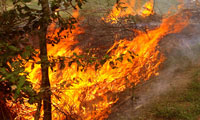Preparing your home for a bushfire

If you live in a bushfire-prone area, here are some things you should do every year to prepare your home for bushfire season—as well as some tips for when fires occur.
Before bushfire season
- Ensure your house number is clearly displayed (for emergency service crews)
- Mow your lawn regularly
- Remove excess combustible material (e.g. dry grass, dead leaves and branches) from your yard
- Move any flammable items such as wood piles, paper, boxes, crates and garden furniture well away from the house
- Trim low-lying branches (those under 2m in height)
- Keep gutters clear of leaf litter
- Buy and test gutter plugs
- Enclose open areas under decks and verandas
- Install fine steel wire mesh screens on all windows and doors
- Make sure any LPG cylinders are upright and relief valves are pointed away from the house
- Check that pumps, generators and water systems are working
- Replace any damaged roofing and seal any gaps
- Check that your first-aid kit is fully stocked.
When a fire front is approaching
- Block drain pipes with gutter pugs and fill gutters with water
- Remove outdoor furniture, door mats and other items
- Move your car to a safe location
- Hose down verandas and vegetation near the house
- Turn on sprinklers in the garden
- Take down curtains and move furniture away from windows
- Fill containers with water, including the bath, sinks, buckets and wheelie bins
- Soak towels and place under external doors
- Have ladders ready for roof access (inside and outside)
- Have a generator and pump ready
- Prepare livestock and pets
- Stay close to the house
- Drink plenty of water
- Patrol your home for spot fires and extinguish them.
When the fire front arrives
If you decide to stay and defend your home, you should:
- take fire-fighting equipment such as hoses and pumps inside (to stop them melting)
- patrol the inside of your home, including the ceiling space for embers or small fires
- shelter inside, drink lots of water and regularly check on family and pets.
After the fire has passed
- Once it is safe to go outside, check for spot fires or embers
- inside the roof space
- under the floorboards
- under the house
- on verandas and decks
- on window ledges and door sills
- in roof lines and gutters
- in garden beds or mulch
- in sheds or carports
- in woodpiles
- on outdoor furniture.
- Stay at home until the surrounding area is clear of fire
- Continue to drink lots of water and listen to your local radio station for updates.
Read more about preparing your home for bushfires.
Cleaning up
Before commencing any clean-up work, ensure it is safe do to so. To minimise further risk:
- Wear appropriate personal protective equipment
- Take care when handling material which may contain asbestos
- Don’t spread ash around the property. This may contain copper, chromium, arsenate (CCA) treated timbers, asbestos or other hazards. Keep children and pets away from ash until clean-up work complete
- Minimise airborne ash by keeping debris wet.
- Be aware of potential hazards which may be hidden under debris, such as smouldering coals and ash, electrical hazards, gas cylinders.
- Disconnect rainwater tank pipes before cleaning the roof to prevent entry of contaminated water
Asbestos
There are added dangers when a fire happens in a building or house that contains asbestos materials.
Asbestos damaged by fire can produce debris—unburnt and partly burnt pieces which release dangerous fibres.
Asbestos fibres are released when the debris is disturbed.
Minimise disturbance of the debris and stay safe around asbestos after a fire by:
- not walking on or through asbestos debris
- erecting a sign and/fence to ensure the area is not accessed by anyone
- contacting 13QGOV (13 74 68) for advice to have the asbestos removed safely.


